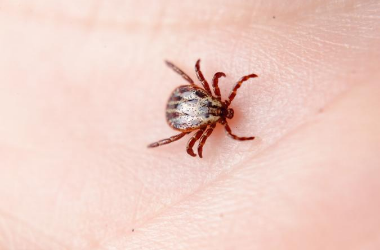So much of 2020 has been unexpected and unpredictable, and by every measure, the summer will be the same way.
Except for ticks. Those tiny parasites are nothing if not predictable…and predictably troublesome.
Of the dozen tick-borne diseases plaguing Americans each year, the most common in the northeast is Lyme disease, characterized by a rash—that’s the bull’s eye pattern you always hear about—and flu-like symptoms. This year, providers at Saratoga Hospital Urgent Care locations have reported a number of cases of Anaplasmosis. Signs and symptoms include fever and chills, severe headache and muscles aches, as well as gastrointestinal problems (nausea, diarrhea, vomiting, loss of appetite).
While early treatment with antibiotics almost always leads to a complete cure, we have a few suggestions to help you and your family avoid tick bites all together while enjoying a little socially-distant summer fun.
- Create a tick-safe zone in your yard. Mow your lawn frequently to keep the grass short. Place your patio furniture, and playground equipment away from the edge of the yard, and in sunny locations, if possible. If you have a wood pile, make sure it’s stacked neatly, and keep your yard free of garbage and unused furniture so ticks don’t have extra places to hide.

- Dress appropriately. Long sleeves and long pants are best when you’re working outdoors, or hanging out in backyards with tall grass. Tuck your shirt into your pants, and you pant legs into your socks. Light colors are best, because you’ll be able to see any bugs crawling on you. When you get home at the end of the day, throw your clothes into the dryer on high heat for about 20 minutes to kill any unseen hitchhikers.
- Do your research when it comes to repellents. The Environmental Protection Agency recommends repellents with an active ingredient like DEET or oil of lemon eucalyptus. They have an online tool to assist you with finding a product that’s right for you and your family. Follow label instructions when it comes to application. Additionally, you can treat clothing with permethrin, an insecticide which remains protective even after several washes.
- Prevent ticks on your pets. Tick bites are often pretty hard to detect on your pets, especially because it can take days to weeks for any wayward symptoms to appear. In the meantime, the ticks could be in your home or lingering outside in heavily-trafficked areas, which is why it’s very important to use a preventative product on your pet. Talk to your veterinarian about what might be best, and always include your pet in any end-of-day tick checks. Look specifically in and around the ears, under the collar and the front legs, between the back legs and toes, and around the tail and eyelids.
- Perform thorough checks at the end of the day. You can do cursory checks throughout the day by running your fingers through your hair and checking any cuffs or folds in your clothing. When you’re finished outside, head to a room with a full-length mirror, if possible. Ticks like warm areas on the body, so check behind your knees, in your elbows and belly button, and under your armpits. Don’t forget your groin and your scalp, as well.
Don’t panic if you happen to find a tick attached to your skin. Follow New York State Department of Health directions for removing ticks safely:
- Use a pair of pointed tweezers, or a tool specific to tick removal.
- Grasp the tick by the head right where it enters the skin, and pull firmly and steadily upwards.
- Place the tick in a small container of rubbing alcohol to kill it.
- Clean the bite wound with rubbing alcohol or hydrogen peroxide, and monitor for the next 30 days. Call your healthcare provider immediately if you develop a rash or flu-like symptoms.
Per the Centers for Disease Control, not all tick bites require antibiotics to prevent tick-borne illnesses. Talk to your healthcare provider to determine if your particular bite may require a prophylactic dose of doxycycline.
If you find a tick or a suspected bite and wish to see a physician while your primary care office is closed, Saratoga Hospital operates urgent care centers in Wilton and Queensbury; additionally, Malta Med Emergent Care is open 24/7 to assess non-life-threatening injuries outside of urgent care hours.
Monday – Friday:
8:00 AM – 4:30 PM
Extended hours, by appointment:
Monday– Thursday:
7:30 Am – 8:00 AM and
4:30 PM – 7:00 PM
Lab hours:
Available during normal and extended business hours
518-886-5600
Fax: 518-886-5880
